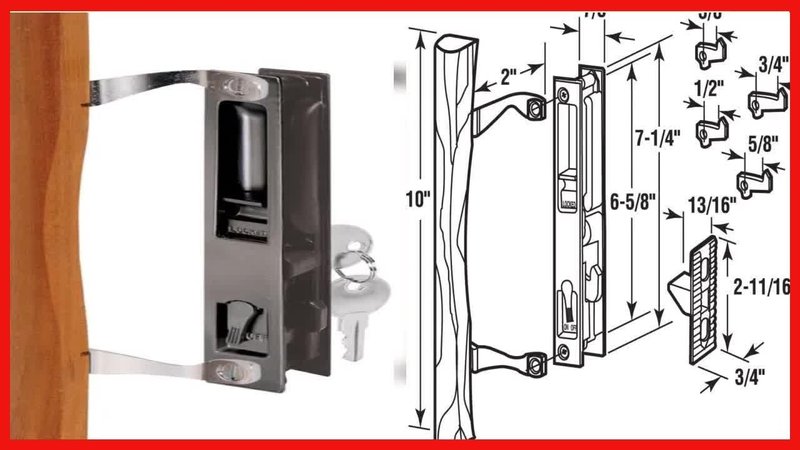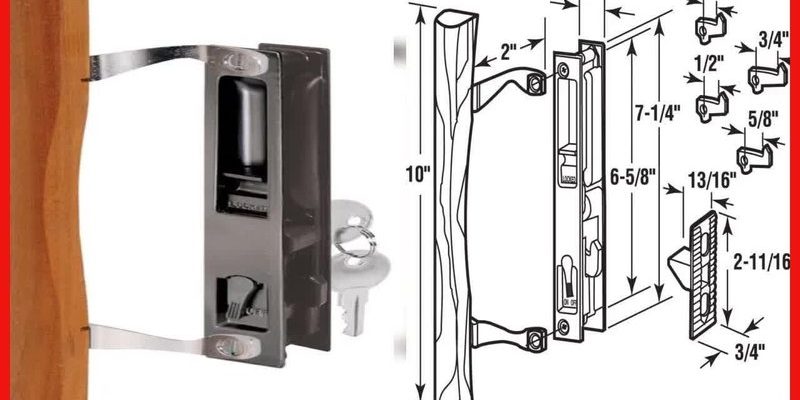
Fixing a bent or damaged backplate can seem intimidating, especially if you haven’t done much door hardware repair before. The pieces are small, and sometimes you have to wrestle with different screws, finishes, or brands like Schlage, Kwikset, or Baldwin. Whether your backplate is a simple rectangle behind a lever or a decorative oval on an ornate handle, the basic repair steps stay about the same. I’ll walk you through the process from start to finish, so you can get your handleset looking and working like new again—no locksmith required.
How To Spot A Bent Or Damaged Handleset Backplate
You might be wondering, “How can I tell if the backplate is actually the problem?” Here’s the thing: a lot of handle and lock issues start with something you can’t see until you look closely. If your handle droops, feels wobbly, or doesn’t line up with the latch anymore, odds are the backplate has shifted or bent from years of use—or maybe from that time someone slammed the door a little too hard.
Check for any visible dents, bowing, or warping on the metal piece behind the handle. Sometimes, a backplate will even crack or split along the screw holes, leaving the handle loose and making it harder to lock or unlock. Pay attention to how the door looks when it’s shut. If you see a gap that wasn’t there before or if the handle tilts at an angle, that’s a clear sign the backplate isn’t holding things straight.
Still unsure? Give the handleset a gentle wiggle. If the whole assembly shifts or the backplate moves independently of the door, that’s your culprit. Don’t ignore small problems—over time, even a minor bend can throw off the whole lock mechanism or leave your home less secure.
Why Do Handleset Backplates Get Bent Or Damaged?
Honestly, most backplates aren’t built to last forever. They take the brunt of day-to-day use—pushing, pulling, slamming, even the occasional accidental bump with a heavy bag. Over time, all that pressure can add up, especially if the handleset wasn’t installed tightly in the first place or if the screws have loosened up.
Certain brands, like Schlage or Kwikset, use slightly thicker or reinforced backplates, but even those can give in after years of tough love. Environmental factors play a part, too. Moisture, rust, and temperature changes can weaken the metal, making it more likely to bend or crack. If you’ve ever lived through a humid summer or an icy winter, you know how much your door hardware can creak and groan.
Sometimes, the damage comes from the inside. If your lock gets jammed and you force it, that torque can stress the backplate. Or, if you’re using universal handleset parts that don’t fit *quite* right, misalignment can quickly wear things down. The good news: with the right tools and a little patience, fixing a bent or damaged backplate is totally doable.
What Tools And Parts Do You Need For Handleset Backplate Repair?
Let me explain what you’ll need before you dive in—because nothing’s more annoying than getting halfway through a repair and realizing you’re missing the right screwdriver.
- Philips and flathead screwdrivers—Most handlesets use one or both types (check your set first).
- Replacement backplate—You can order brand-specific plates (Schlage, Kwikset, Baldwin) or universal backplates, depending on your handleset.
- Pliers or a small wrench—Helpful for bending metal back or removing stubborn screws.
- Lubricant spray—WD-40 or silicone spray works for stuck parts.
- Measuring tape—To check sizing if you’re swapping in a new plate.
- Optional: power drill—For tough or stripped screws.
It’s smart to have everything on hand before you start. If you’re replacing a branded plate, double-check that you have the right part code. Universal options can work in a pinch, but make sure the screw holes line up with your handleset for a secure fit. A small dish helps keep track of screws and springs—those little guys love to roll away!
Step-By-Step Guide: Fixing A Bent Or Damaged Handleset Backplate
Ready to get your hands dirty? Here’s how you can repair or replace a bent backplate, step by step. This process works for most common brands and universal sets.
- Remove the handleset. Start by unscrewing the handle and lock from the door. Keep all screws and parts organized so nothing goes missing.
- Inspect the backplate. Once the handleset is off, look at the backplate from every angle. If it’s only slightly bent, you might be able to straighten it out with pliers. If it’s cracked or badly warped, replacement is the safer bet.
- Straighten or swap the backplate. For minor bends, carefully bend the plate back into shape. Go slow—rushing can snap the metal. For replacements, line up your new plate and check that screw holes and fits match exactly.
- Reassemble the handleset. Put the handleset and new or fixed plate back onto the door. Tighten screws firmly, but don’t overdo it. If you’re using a universal backplate, make sure all holes and handle positions line up properly.
- Test the lock and handle. Open and close the door a few times. The handle should move smoothly, and everything should feel snug—not wobbly or loose.
Take your time with each step. Rushing can strip screws or warp the new plate—slow and steady wins the repair race!
What If You Can’t Find An Exact Handleset Backplate Match?
You might be stuck with an older or discontinued handleset. In that case, finding a brand-name backplate to match your existing code—or even a universal backplate that fits—can turn into a bit of a treasure hunt.
Here are your main options if you’re having trouble matching:
- Contact the manufacturer. Big brands like Schlage or Kwikset usually have customer support that can track down part numbers for you, even for older sets.
- Try universal replacement kits. These often come with multiple screw hole patterns or adjustable plates. They might not be an exact match, but with a little tweaking, they usually work.
- Visit local locksmiths or hardware stores. Sometimes, they’ll have generic or scavenged parts that aren’t listed online.
If you do go the universal route, keep in mind that finish, size, and screw alignment may not be a perfect match. It’s a solid plan for function, but you might notice a slight difference in appearance. For older doors where aesthetics matter, you can always paint or finish the plate to blend in.
Comparing Universal Vs Branded Backplates
You might be weighing the pros and cons of a universal backplate versus one made by your handleset’s brand. Here’s the real scoop:
- Branded backplates (like Schlage or Kwikset) are made to fit your handleset exactly—right finish, right screw pattern, right size. They’ll look cleaner and last longer, but they can be pricier and harder to find, especially for older models.
- Universal backplates are cheaper and easier to track down. They’re designed to work with lots of different handlesets and can be a lifesaver if your model is discontinued. But, honestly, sometimes you’ll need to drill new holes or accept a less-than-perfect fit.
There’s no wrong answer—it depends on your priorities. If you care most about looks and matching finishes, branded is probably worth the hunt. If you just want the door working again and don’t mind a tiny mismatch, universal will do the trick.
Common Mistakes To Avoid When Repairing Handleset Backplates
I’ve seen a lot of folks get tripped up by simple mistakes during this repair. Here’s what to watch out for:
- Using the wrong screws—Mixing up screw lengths or types can keep the plate from sitting flush. Always save and reuse the originals if possible.
- Overtightening—It’s tempting to crank down on every screw, but overtightening can actually bend a new plate or strip screw holes.
- Forcing a warped plate—Trying to bend a badly cracked or brittle plate back into shape often makes it worse. If the damage is too bad, just replace it.
- Ignoring alignment—If things don’t line up, the whole handleset can feel off. Take an extra minute to measure and adjust before reattaching everything.
If something feels wrong or the handle still wobbles after you’re done, double-check the backplate and all your screws. Sometimes, the smallest adjustment makes a big difference.
How To Prevent Future Handleset Backplate Damage
You’ve got your handleset sturdy and straight—now, let’s keep it that way. A little routine maintenance saves a lot of hassle later.
- Tighten all screws a couple of times a year—handlesets naturally loosen with everyday use.
- Clean off grime and moisture—even quality plates rust over time if water sits on them.
- Smooth any sticking locks with graphite or spray lubricant—never force a stuck lock or handle.
- Don’t slam the door—it’s simple advice, but over time, repeated force is what usually bends or cracks the plate.
If you live in a high-humidity or coastal area, consider waxing or coating the backplate with a clear spray to slow down corrosion. It doesn’t take much time, and your door hardware will thank you.
When To Call A Professional Or Replace The Whole Handleset
Here’s the honest truth: not all repairs are DIY-friendly. If your handleset backplate is severely warped, split around the screw holes, or you just can’t get the lock to line up and code correctly after your repair, it might be time to call a locksmith or replace the entire set.
Most pros can swap out a handleset or deal with hard-to-find parts in under an hour. It costs a bit more, but you’ll get peace of mind that the job’s done right. And sometimes, replacing the handleset with a compatible new model (especially if the remote or battery components are outdated) gives you all-new hardware and a fresh look for your door.
If security is a concern, don’t hesitate—your door’s only as strong as its weakest piece, and a badly damaged backplate can leave your home vulnerable.
Wrapping Up: A Straightforward Fix For A Stronger Door
Repairing a handleset backplate that’s bent or damaged isn’t just about looks—it helps your whole lock set work smoothly and keeps your door safe. Whether you’re dealing with a classic Schlage, a vintage Baldwin, or a universal handleset, taking the time to inspect, repair, or replace the backplate is well worth it. Go slow, use the right parts, and pay attention to the little details. That simple bit of maintenance means fewer problems down the road, a smoother lock, and a safer home—plus, you get the satisfaction of a job well done.
